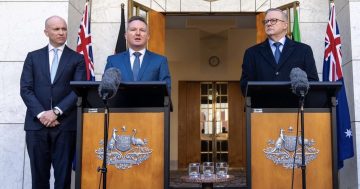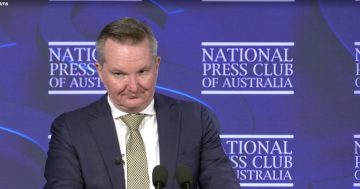
Climate Change Authority chair Matt Kean used an estimates hearing to describe the nuclear industry as rent seekers. Photo: Climate Change Authority.
It was conservative against conservative in the latest round of Senate Estimates when a former NSW minister took on a Coalition senator over nuclear energy.
Climate Change Authority chair Matt Kean slammed the nuclear industry during his first appearance at Estimates since taking on the role in June.
He was formerly the NSW energy minister.
Mr Kean told the hearing there was “no bigger rent-seeking parasite” than the nuclear industry.
“If you want to see who are needing rent-seeking, trying to pull one over the eyes of the Australian public, it’s the nuclear industry,” he said.
Mr Kean said the nuclear industry was “propping up” the coal industry and helping it to “squeeze out the last bits of profit” at the expense of Australian consumers.
Nationals senator Ross Cadell accused Mr Kean of not looking for the truth or questioning things such as CSIRO research.
A recent CSIRO report found nuclear power was the most expensive form of large-scale energy available to Australia and that a primary plant would cost more than $16 billion.
Senate Cadel said the Climate Change Authority should not automatically accept that kind of research.
But Mr Kean shot back and defended Australia’s premier science organisation.
“Most rational people do trust the CSIRO, this is the body that developed Wi-Fi,” he said.
“[Their] advice is good enough for me and it should be good enough for our political leaders.”
Mr Kean also accused Senator Cadell of “trying to get your grabs up on Sky”.
In June, Opposition Leader Peter Dutton revealed the intended locations of seven nuclear power stations he wants to build across Australia if the Coalition wins the next federal election.
But beyond providing dots on the map, the Opposition Leader gave scant information about his plan.
There were no costings and only a rough timeline committing to having the first plants in operation between 2035 (if using smaller-module reactors) and 2037 (if larger reactors are chosen).
The Federal Government would own the assets but form partnerships with experienced nuclear companies to build and operate them.
A community partnership would also be formed in each host area, consisting of experienced local representatives, to help with local engagement and play a role in planning the future of their regions.
When making the announcement, Mr Dutton said the community engagement process would occur alongside a comprehensive site study that would include detailed technical and economic assessments.
Each site would be located at a power station that has closed or is scheduled to close.
The locations are Liddell Power Station in NSW; Mount Piper Power Station, NSW; Loy Yang Power Stations in Victoria; Tarong Power Station in Queensland; Callide Power Station, Queensland; Northern Power Station in South Australia; and Muja Power Station in Western Australia.
The following month, Australia’s federal, state and territory agriculture ministers united in an almost unanimous call for Mr Dutton to explain what impact his nuclear energy plan would have on the nation’s farming sector.
The ministers expressed “serious concern” about the potential impact of nuclear reactors on Australian agriculture.
They said almost 12,000 farms were within 80 kilometres of the sites Mr Dutton had earmarked for nuclear reactors.
The Tasmanian Government, which was the only Liberal-held jurisdiction across Australia at the time, was the only one not to support a joint ministerial statement.
There is no nuclear site earmarked for Tasmania.
The other ministers demanded some answers.
“As the nation’s agriculture ministers, we have a duty to protect and grow the industry we represent in our respective jurisdictions,” their joint statement said.
“We have serious concerns that this duty would be compromised by the Federal Opposition’s proposal for nuclear power in and around prime agricultural land.
“An estimated 11,955 farms are situated within 80 km of the seven nuclear reactors that the Federal Opposition has proposed for construction across regional Australia.”
Original Article published by Chris Johnson on Riotact.











